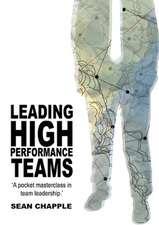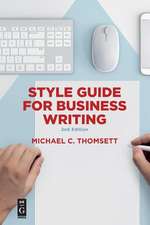What Every Board Member Needs to Know: The Art of Governance: The Alexandra Lajoux Corporate Governance Series
Autor Bailey, Deborah Hicks Midaneken Limba Engleză Paperback – 22 mai 2018 – vârsta de la 22 ani
Preț: 342.99 lei
Nou
65.63€ • 70.18$ • 54.72£
Carte disponibilă
Livrare economică 27 martie-10 aprilie
Specificații
ISBN-10: 1547416440
Pagini: 200
Dimensiuni: 155 x 230 x 21 mm
Greutate: 0.45 kg
Editura: de-G Press
Seria The Alexandra Lajoux Corporate Governance Series
Notă biografică
Deborah Hicks Midanek, Principal, Prevail Investments, LLC; Vice Chairman & Independent Director, Innovate MS., USA
Cuprins
Part I: The System and How It Came To Be ¿ 1
Chapter 1: How Our Governance System Began ¿ 3
The First Limited Liability Corporation ¿ 3
Amsterdam Stock Exchange Established to List VOC Securities ¿ 4
VOC Completes Initial Public Offering, Possibly World's First ¿ 4
The Governance of VOC Establishes the Model ¿ 5
The Lords Seventeen Governance Structure Drawn from Guild
System ¿ 5
VOC Confronts a Large Activist Shareholder ¿ 6
. . . And a Bear Syndicate ¿ 6
The Corporate Form Advances and Spreads-And with It, the Board ¿ 7
Corporations Arrived in the New World ¿ 8
And Bubbles Burst ¿ 9
Chapter 2: The Emergence of the Corporation in United States ¿ 11
New York Pioneers Simple Incorporation Procedure ¿ 11
Boston Manufacturing Company is First Private Corporation in United
States ¿ 12
Corporations Gain Power Under State Control ¿ 13
Economic Opportunity Expands; Farmers and Artisans Suffer
Disruption ¿ 14
Corporate Control is Concentrated ¿ 15
How J.D. Rockefeller Went from Rags to Riches ¿ 15
The Government Fights Back, Kind Of ¿ 16
Early Days of the New York Stock Exchange ¿ 17
Teddy Busts the Trusts ¿ 19
Government Power Takes on Commercial Power: Teddy v J.P. ¿ 19
Unintended Consequences Lead to More Antitrust Laws ¿ 20
Chapter 3: Post-World War I Developments ¿ 23
The Stock Market Crashes ¿ 23
The Great Depression and FDR's New Deal ¿ 23
Safety Net for Banks Created ¿ 24
Regulation of Securities and Securities Markets Takes Root ¿ 25
Safety Net Extended to Citizens as Social Security is Born ¿ 25
Frustration Sets in as Unemployment Persists ¿ 26
Government and Business Mobilize for World War II ¿ 27
Roosevelt and Business Create Formidable Alliance ¿ 27
Solidarity Works Miracles ¿ 28
Wartime Success Reaches Far Beyond Battlefields ¿ 29
Chapter 4: The Glow Following World War II ¿ 31
The 1950s Board Role ¿ 31
Stock Market Investing is Patriotic Duty ¿ 32
The Nifty Fifty Catches On ¿ 33
Investor Relations Become a Corporate Function ¿ 34
Chapter 5: Shifting Dynamics from 1970 to 2000 ¿ 35
Agency Theory is Born ¿ 35
The Stock Market Corrects ¿ 36
Outrage over the Wreck of Penn Central Fuels New Focus on Board
Role ¿ 36
Broad Corruption Revealed Leads to Focus on Governance Per Se ¿ 37
The Board as Overseer Takes Root as Independent Directors Become
Desirable ¿ 38
The Definition of Independence Proves Elusive; We Know It When We
See It ¿ 38
The 1980s Board Role: The Board Becomes Important ¿ 39
Mighty Institutional Investors Weigh In ¿ 40
The Courts Recognize Independent Judgment of the Board as Mission
Critical ¿ 41
Economic Uncertainty and Social Unrest Reduce American
Confidence ¿ 42
Market Crashes on Black Monday ¿ 42
Changing Market Forces Become Visible ¿ 43
NYSE Establishes Safeguards ¿ 43
The 1990s Board: Independence Criteria Tighten as Equity Linked
Compensation Grows ¿ 44
True Independence Grows in Value ¿ 45
Equity Linked Compensation Creates Moral Hazard ¿ 46
Independence of Mind Needs Help from Independence of
Process ¿ 46
Revolving CEOs ¿ 47
Chapter 6: Post 2000 Intensification of Focus on the Board ¿ 49
Corruption Eruption Leads to Sarbanes Oxley and Growing Focus on
Board ¿ 50
The Functioning of the Board of Directors Gains Attention ¿ 52
Sarbanes-Oxley Act ¿ 54
Part II: The Players and Capital Market Forces ¿ 59
Chapter 7: The Rise of Independent/Disinterested Directors ¿ 61
Considering Independent Director Effectiveness ¿ 61
Dueling Definitions ¿ 62
New York Stock Exchange Listing Requirements Stress Independence of
Directors ¿ 62
Independent Directors Fill a Structural and Legal Need ¿ 66
Chapter 8: The Rise of Institutional Investors ¿ 69
Mutual Fund Development ¿ 69
Comments from Mutual Fund Leader John C. Bogle ¿ 71
The Growth of Passive Investing ¿ 74
The Defined Benefit Pension Plan Grows ¿ 75
Employee Retirement Income Security Act of 1974 (ERISA) Strengthens
Pension Rules ¿ 76
The Defined Benefit Pension Plan Declines ¿ 77
Retirement Assets Shift into Mutual Funds ¿ 78
Public Sector Pension Plans ¿ 78
The Growing Pension Crisis ¿ 79
Investing by Public and Private Plan Fiduciaries ¿ 80
Shifting Patterns of Share Ownership in United States ¿ 82
The Perils and Possibilities of Concentrated Share Ownership ¿ 83
The Rise of Proxy Advisor Power ¿ 84
Proxy Advisors Helped Interpret High Volume of Information ¿ 85
Responsible Voting of Proxies in Best Interests of Clients
Required ¿ 85
Proxy Advisors Take Heed: Physician, Heal Thyself ¿ 86
Chapter 9: The Impact of The Great Inflation ¿ 89
The Seeds of the Great Inflation Are Sown by the Fateful Phillips
Curve ¿ 89
Our Economy Fights Another War, on Several Fronts ¿ 91
Employment v. Inflation ¿ 91
Federal Reserve Chairman Volcker Toughs It Out ¿ 92
Impact of Prolonged Inflation on Capital Market Innovation ¿ 94
Securitization Solves a Genuine Problem, and Turns the World Upside
Down ¿ 94
Not Your Daddy's Trading Floor ¿ 95
Interest Rate Arbitrage Comes of Age with the Swap Market ¿ 96
Chapter 10: Mortgage Backed Securities and Structured Products
Conundrums ¿ 99
Using Securitization Techniques, the Sky Was the Limit-Or Maybe
Not ¿ 100
The Mortgage Derivative Market Implodes ¿ 101
Hark, Securitization of Sub Prime Mortgages Begins ¿ 101
Earnings as Defined by Generally Accepted Accounting Principles May
Not Create Cash ¿ 102
Sub Prime Industry Almost Died in 1998 ¿ 103
Public Policy Starts the Subprime Cycle Again ¿ 103
Repeal of Glass Steagall Act Allows Commercial Banks and Investment
Banks to Compete ¿ 104
And We Pushed Ourselves into the Abyss ¿ 105
Low Interest Rates Fuel Frenzies in Multiple Arenas ¿ 105
Collateralized Debt Obligations Explode, In More Ways Than
One ¿ 106
The Abyss Itself ¿ 106
Multiple Financial Institutions Fail ¿ 107
And WaMu, Too, Bites the Dust ¿ 108
Chapter 11: The Aftermath of the Abyss ¿ 111
Chapter 12: The Rise of Leveraged Buyouts, High Yield Bonds, and Private
Equity Investment ¿ 113
No Longer Your Granddaddy's Way to Buy a Company ¿ 113
The Venture Capital Firm is Born ¿ 114
The Private Equity Fund is Born ¿ 114
The Leveraged Buy Out Arrives ¿ 115
Pension Plans Buy in to Private Equity Investing ¿ 116
The Hostile Takeover Epidemic ¿ 117
The Role of Michael Milken ¿ 117
Milken Flexes His Funding Muscles ¿ 118
Corporate Titans Are Shaken by an Upstart ¿ 119
The Government Fights Back-For Real ¿ 119
Giuliani Plays Hardball with RICO Threat ¿ 120
Milken Pleads, and NOT to Engaging in Insider Trading ¿ 121
And Drexel Fails ¿ 122
And Restructures Its Own Board of Directors ¿ 122
Lasting Impact of Milken and Drexel Burnham ¿ 123
Private Equity Goes Public ¿ 123
Chapter 13: The Rise of Hedge Funds and Emergence of Aggressive
Activism ¿ 125
Hedge Funds Remain Largely Opaque and Unregulated ¿ 125
Hedge Funds Emerge as Activists ¿ 126
Traditional Institutional Investors Join the Fray ¿ 127
The Current Impact of Activism ¿ 128
Voting Results on Shareholder Proposals ¿ 129
Chapter 14: The Evolution of the New York Stock Exchange ¿ 131
Part III: The Role of The Board ¿ 133
Chapter 15: Clarifying the Rights and Roles of the Board and the
Shareholders ¿ 137
The Board Serves the Corporation as Its Agent ¿ 138
The Powers of the Board ¿ 139
Public Company Ownership ¿ 140
Functional Principles of the Board ¿ 141
Accountability of the Board ¿ 143
Defining Board Success ¿ 143
The Purpose of the Corporation Project ¿ 145
Short Termism Really Is a Problem ¿ 146
Chapter 16: Assessing the Proliferating Policies and Principles ¿ 149
OECD Encourages Adoption of National Codes of Governance ¿ 150
Other Voices Join in ¿ 150
Chapter 17: Considering the Proposed New Paradigm ¿ 153
Summary Roadmap for the New Paradigm ¿ 153
The New Paradigm Attempts a Synthesis of Good Corporate Governance
Concepts ¿ 155
Proposed Investor Behavior ¿ 158
New Paradigm Proposes Integrated Long-Term Investment Approach ¿ 159
Proposed Integration of Citizenship Matters into Investment
Strategy ¿ 159
Proposed Disclosure of Investor Policies and Preference ¿ 160
And Now Comes CIRCA, Council for Investor Rights and Corporate
Accountability ¿ 161
Activist Playbook ¿ 162
Proxy Fights and Shareholder Candidates ¿ 163
The Bower and Paine Analysis of Maximizing Shareholder Value as
Corporate Goal ¿ 163
The Dangers of Agency Theory ¿ 165
Part IV: Doing the Job ¿ 169
Boards Must Protect Corporation Regardless of Conflicting Agendas ¿ 169
Chapter 18: Review Issues for Boards to Address Highlighted by NYSE ¿ 171
Executing the Work of the Board ¿ 173
Chapter 19: Establish the Appropriate "Tone at the Top" ¿ 175
Relentless Focus on Ethical Behavior and Discerning the Right Thing to
Do ¿ 178
Training as to What Ethical Behavior Means is Important in Our
Changing World ¿ 179
Ensure Reports on Compliance are Made Directly to the Board
Periodically ¿ 179
Chapter 20: Choose the CEO Wisely and Actively Plan for Succession ¿ 181
Keep the Emergency Succession Plan Current ¿ 181
Build a Future View of Company Needs into Longer Term Succession
Planning ¿ 182
Setting Criteria and Developing Possible Candidates ¿ 182
Work with the Incumbent ¿ 183
Know Your Senior Management Team ¿ 184
Chapter 21: Develop a Strong Organizational Framework ¿ 187
Chapter 22: Tailor Board Work to the Company ¿ 189
Board Leadership ¿ 189
Committee Structure ¿ 190
Audit Committee ¿ 192
Compensation Committee ¿ 194
Nominating and Corporate Governance Committee ¿ 195
Other Committees ¿ 196
Special Committees ¿ 196
Special Negotiation Committee ¿ 196
Special Litigation Committee ¿ 197
Special Investigation Committee ¿ 197
Board Information ¿ 198
Information Security ¿ 198
Collegiality ¿ 199
Manage Communication Mindfully ¿ 199
Executive Session ¿ 201
Meeting with Management ¿ 201
Setting the Agenda ¿ 202
Facilitate Candid Communication and Trusting Relationships ¿ 202
In Crisis the Buck Stops with the Board ¿ 203
No Time to Resign ¿ 204
Chapter 23: Focus Intently on Compensation ¿ 205
Executive Compensation ¿ 205
Fairly Compensate Directors ¿ 205
Chapter 24: Seek Wisdom, Courage and Breadth of Experience in Director
Recruitment ¿ 207
Get the Right Mix of Directors in the Boardroom ¿ 208
Value Tempered Judgment over Technical Expertise ¿ 2108
Chapter 25: Actively Evaluate Board Performance to Constantly
Improve ¿ 213
Developing the Process ¿ 213
Chapter 26: Manage Risk Effectively ¿ 217
Further Comments on the Board and Cybersecurity ¿ 220
Never Underestimate the Impact of Human Error ¿ 221
Importance of Plans ¿ 221
Chapter 27: Independently Evaluate the Impact and Execution of
Transactions ¿ 223
Chapter 28: Communicate Clearly, Consistently and Constantly ¿ 225
Part V: Hazards and Their Navigation ¿ 229
Chapter 29: Address Individual Hazards and Personal Fear ¿ 231
Liability Concerns ¿ 231
Efforts to Insulate Directors ¿ 232
Directors and Candidates Should Understand the Protections They
Have ¿ 234
Beware the Responsible Corporate Officer Doctrine ¿ 234
Chapter 30: Navigate Corporate Hazards and Distressed Situations ¿ 237
Liquidity: What to Do When Cash Runs Low ¿ 238
Form a Board Committee to Focus Closely on the Emergency ¿ 238
Is This Really a Role for the Board? ¿ 240
The Corporation Is Counsel's Client; The Board Retains Counsel ¿ 241
The Next Step: Assess Viability ¿ 241
Bringing in Help ¿ 244
Assessing Leadership Resources ¿ 245
Structuring the Leadership Role ¿ 245
Communicate the Plan, and the Progress ¿ 246
Just Do It ¿ 247
Appreciation of the Effort Put in Goes a Long Way ¿ 248
Yes, Virginia, You Did Sign Up for This ¿ 248
Becoming the Debtor in Possession ¿ 248
Chapter 31: Recognize and Rectify Hazards of Board Process ¿ 251
Continuing Confusion as to Responsibility and Authority ¿ 251
Group Think ¿ 252
Faulty Filters ¿ 252
Corporate Myths ¿ 253
Conformity Pressure ¿ 253
The State Dinner ¿ 254
Bullying ¿ 254
Chapter 32: Know that Steady, Purposeful Work is the Antidote ¿ 255
Reading the Room ¿ 255
Preparing ¿ 256
Owning Your Style ¿ 256
Finding Your Point of View-and Theirs ¿ 256
Leading with Your Ears ¿ 257
Addressing Biases ¿ 257
Overconfidence ¿ 258
Confirmation Bias ¿ 258
Survival Bias ¿ 259
Attribution Bias ¿ 259
Building a Championship Team ¿ 260
Dissent is Not Disloyalty ¿ 261
Building a Portfolio of Roles ¿ 261
Chapter 33: Survive Success and Relentlessly Build Resilience ¿ 263
Conclusion: Own the Role and Build the Future ¿ 267
Index¿ 269

















